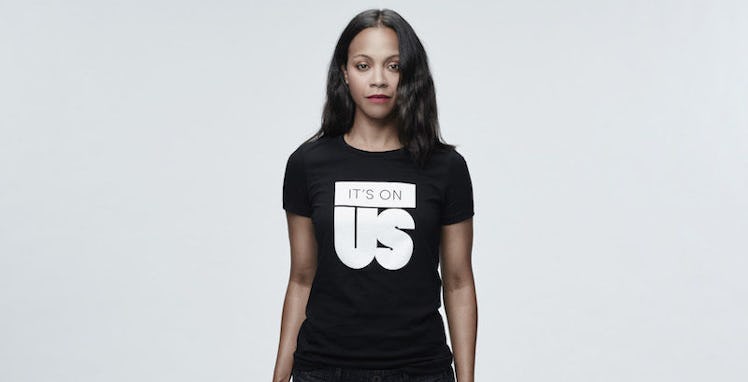
4 Ways This Generation Can Combat Sexual Violence On College Campuses
Earlier this year, Columbia graduate Emma Sulkowicz made headlines when she carried her mattress around campus, in protest of her school's treatment of her case after her alleged rapist was cleared of responsibility.
He said it was consensual. She obviously disagreed.
But the real question is this: Why does consent, which is so easily definable, become a murky concept when it comes to sex?
The White House recently issued a video about consent as part of their "It's On Us" campaign, and RAINN dedicated an entire section on its site, delineating what constitutes as rape or sexual assault. To make it even clearer, artist Alli Kirkham explained it in her comics by illustrating consent in everyday scenarios.
Having grown up with the Internet, we take for granted having access to information at our finger tips. But it still doesn't seem to be enough.
A recent study found that 37 percent of Millennials said sex ed classes weren't helpful when it came to making decisions about sex and relationships. And a quarter of Millennials say they didn’t have ANY sexual education in high school.
College is intimidating enough, so coming into it with very little experience or knowledge could lead to uncomfortable or unsafe situations.
According to RAINN, 80 percent of sexual assault victims are under the age of 30, and 44 percent are under the age of 18. This issue is affecting Millennials, and it’s an “equal opportunity epidemic,” which means it can happen to anyone.
The beginning of the fall semester through Thanksgiving is known as "the red zone" because there are more sexual assaults on college campuses during this period than any other time during the school year. Every 21 hours, there is a rape on an American college campus.
In order to make a change, we need to be the change.
Vice President Biden said it best: "We need all of you to be part of the solution. This is about respect; it’s about responsibility.”
1. Educate yourself and campaign for education in schools.
Affirmative consent "is a knowing, voluntary and mutual decision among all participants to engage in sexual activity."
According to the National Center for Higher Education Risk Management, an estimated 1,400 institutions of higher education now use some definition of affirmative consent in their sexual assault policies.
It's easier to get taken advantage of when you're unaware of what that can look like. Just because it started out consensual, doesn't mean you have to continue if you're in any way uncomfortable.
The various tenets of affirmative consent include, "Consent to any sexual act or prior consensual sexual activity between or with any party does not necessarily constitute consent to any other sexual act."
By educating yourself and promoting education for others, you are helping to start a dialogue and developing a safe space for people to voice their questions or concerns.
Other ways to promote safety and education is through anti-violence posters, sexual safety campaigns, safety plans for victims, increased security in areas where students feel most unsafe and group discussions with a regular availability of counselors.
2. Communicate your intentions and your limits.
“Silence or lack of resistance, in and of itself, does not demonstrate consent.”
Whenever we hear the word "rapist," we probably think of a hooded stranger lurking in dark corners. But the reality is, 47 percent of rapists are a friend or acquaintance. Familiarity doesn't equate consent, no matter how close you are to that person.
Therefore, it's important to always make your intentions clear from the get-go.
In the heat of the moment, body language is the loudest. But just because it seems you're both on the same page, doesn't mean you're both expecting the same outcome, so voice your expectations and your consent.
3. Don't be ashamed or afraid to speak up.
A recent article in the New York Times interviewed a young student who never spoke up, because of the stigma she feared she'd face.
“It wasn’t something we’d agreed upon,” she said. “It wasn’t sexy.” She told him to stop and tried to push him away, and that’s when “he covered my mouth with his hand” until he was finished.
She never told anyone: not a friend, not a counselor and not her family.
“They’d never look at me the same again. I don’t have that kind of courage,” she said, “but I commend all strong women who do.”
One way to remove the stigma is to talk about it,
Do not be afraid to seek help. It's certainly not an easy process, but it's one that will help you and others in the long run.
The nonprofit Culture of Respect outlines the different ways you can seek help, and gives you ways to ensure you have enough evidence, should you choose to take legal action.
4. Use technology to your advantage.
Besides the loads of books and school supplies one has to carry, another thing everyone has at all times is his or her phone.
If you feel unsafe, there are apps you can use. The award-winning Circle of 6 is a personal safety app that allows you to easily communicate with a friend if you need a ride, or have a pretend phone call as an interruption to get you out of an uncomfortable situation.
These kinds of apps can also connect you to national and local hotlines. LiveSafe allows you to communicate with local safety officials, and Companion allows you to have a virtual companion for your walk home. Your location info is also given to your campus.